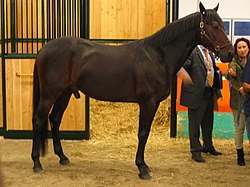 | |
| Conservation status | FAO (2007): not at risk [1] : 71 |
|---|---|
| Other names | Trottatore Italiano |
| Country of origin | Italy |
| Distribution |
|
| Use | trotting races |
| Traits | |
| Height |
|
| Colour | any |
The Italian Trotter, Italian : Trottatore Italiano, is the Italian breed of trotting horse. [3] It has been selectively bred exclusively for its racing ability. Varenne, one of the most successful trotters in the history of the sport, was an Italian Trotter.